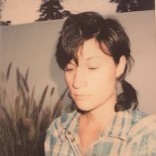The Keno Caller at the Oxford Cafe in Missoula
Roy Bentley
stands before a Sony microphone, belts out
The number is 7! A woman in a housedress
lays out sugar packets in rows as she follows
a paper card, a thin square of white she marks
with a blue crayon-half in the bar’s spilled light.
The caller is as homegrown as the gaits of horses,
one of which altered the fretboard of his vertebrae.
A tv behind the bar blares that half a million souls
have been disappeared by a tsunami. I’m seated
at a table by a wall. Alone. Under a bison head.
In the glow of a Rainier sign, I’m a boy again:
waiting in the pit area of Kil-Kare drag strip.
I’m waiting for my father and his driver, Lou.
Swales of tire smoke zebra a Crayola-red sky,
a tinny PA system rattling on that Lou has lost
The caller at the Ox is sending a spark shower
from Lou’s ’61 Plymouth, his announcer patter
connecting crayoned-in dots of remembrance.
Limits of time and memory restrict the heart
like the band on the roll of currency a local
sails by to collect. I want a card. Because
I want not to see the caller drag himself
to the door of the Men’s room. I want
to see Missoula, Montana and the caller
in a decent light. My father would do that,
look away, when Lou lost or blew an engine.
In a booth the Sugar Lady arranges packets
as if grace is the etcetera we make happen
above the roar and against great odds.
Read more »
The number is 7! A woman in a housedress
lays out sugar packets in rows as she follows
a paper card, a thin square of white she marks
with a blue crayon-half in the bar’s spilled light.
The caller is as homegrown as the gaits of horses,
one of which altered the fretboard of his vertebrae.
A tv behind the bar blares that half a million souls
have been disappeared by a tsunami. I’m seated
at a table by a wall. Alone. Under a bison head.
In the glow of a Rainier sign, I’m a boy again:
waiting in the pit area of Kil-Kare drag strip.
I’m waiting for my father and his driver, Lou.
Swales of tire smoke zebra a Crayola-red sky,
a tinny PA system rattling on that Lou has lost
by blowing what the voice calls “a decent light.”
The caller at the Ox is sending a spark shower
from Lou’s ’61 Plymouth, his announcer patter
connecting crayoned-in dots of remembrance.
Limits of time and memory restrict the heart
like the band on the roll of currency a local
sails by to collect. I want a card. Because
I want not to see the caller drag himself
to the door of the Men’s room. I want
to see Missoula, Montana and the caller
in a decent light. My father would do that,
look away, when Lou lost or blew an engine.
In a booth the Sugar Lady arranges packets
as if grace is the etcetera we make happen
above the roar and against great odds.















